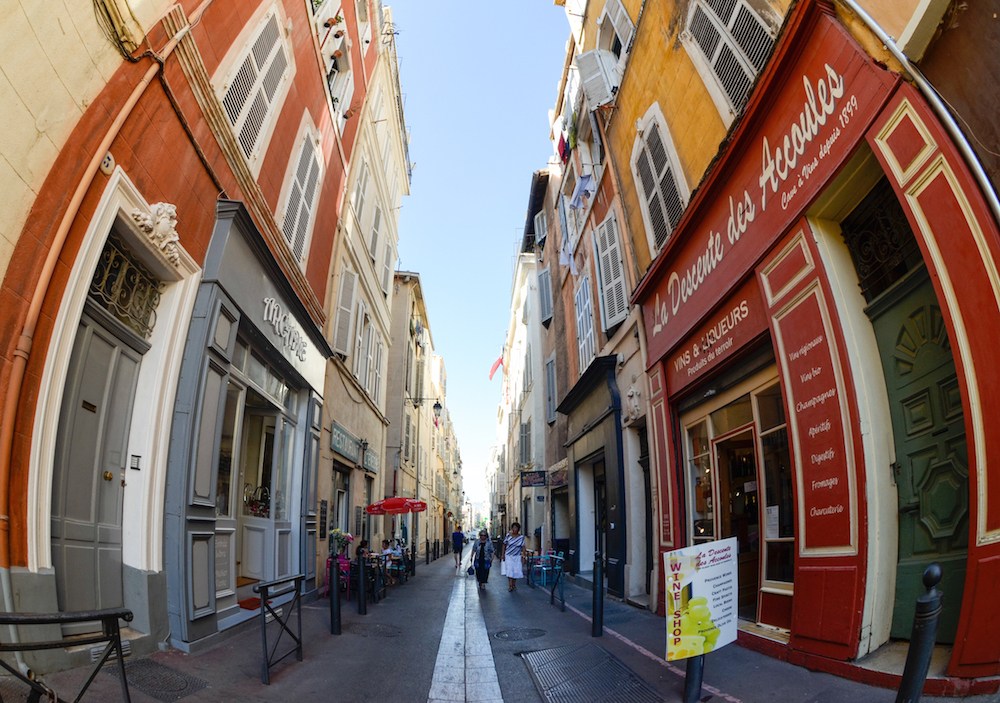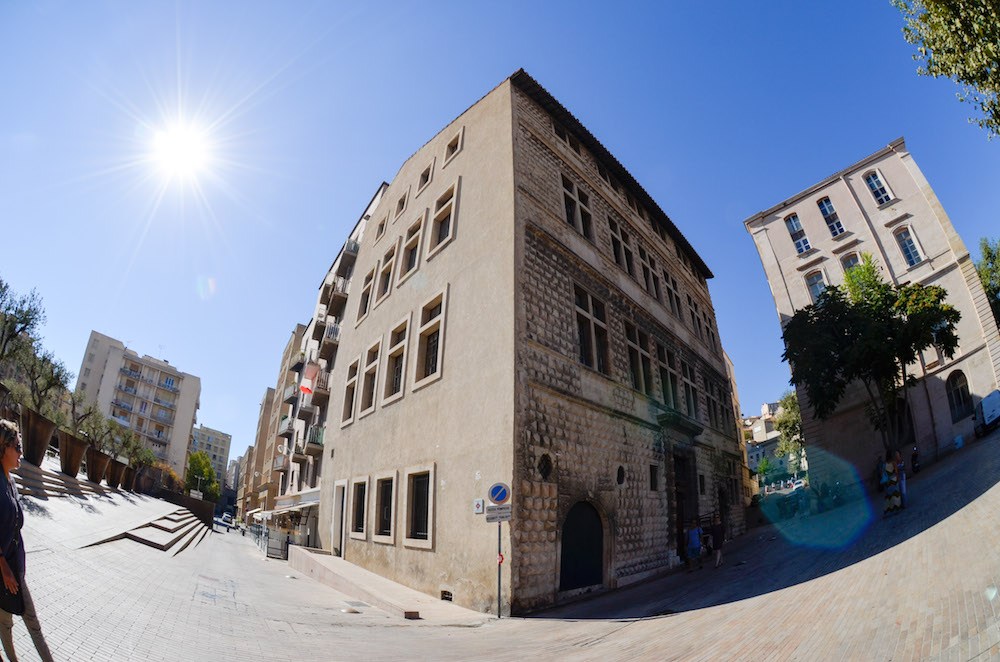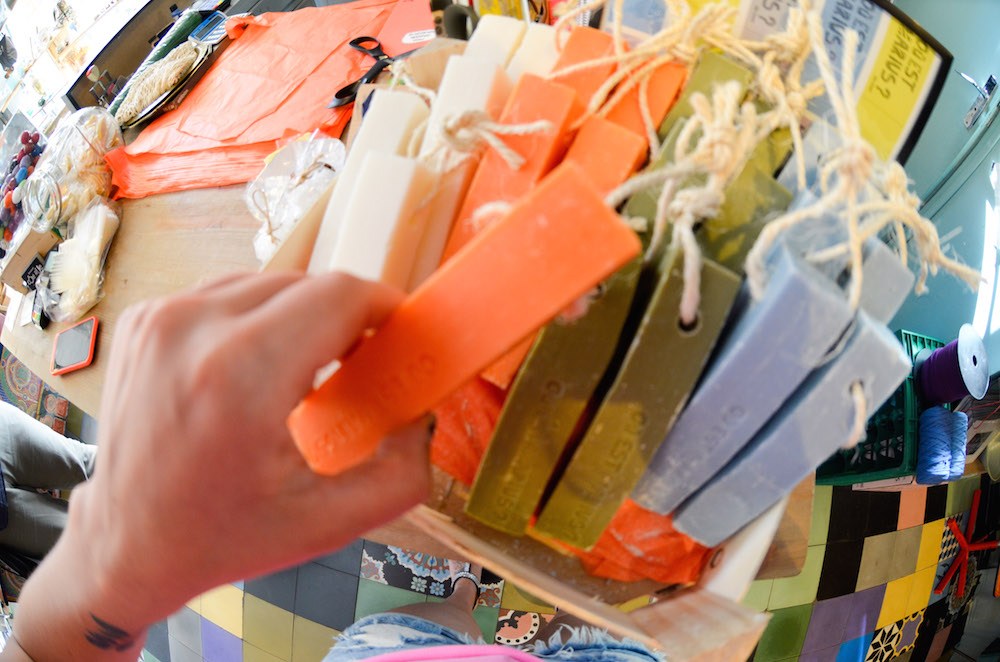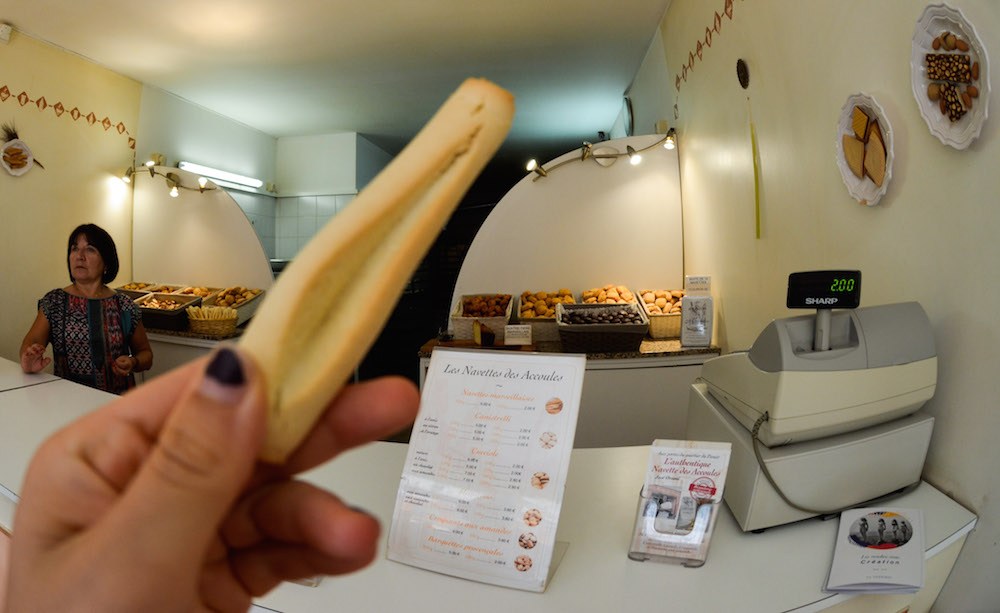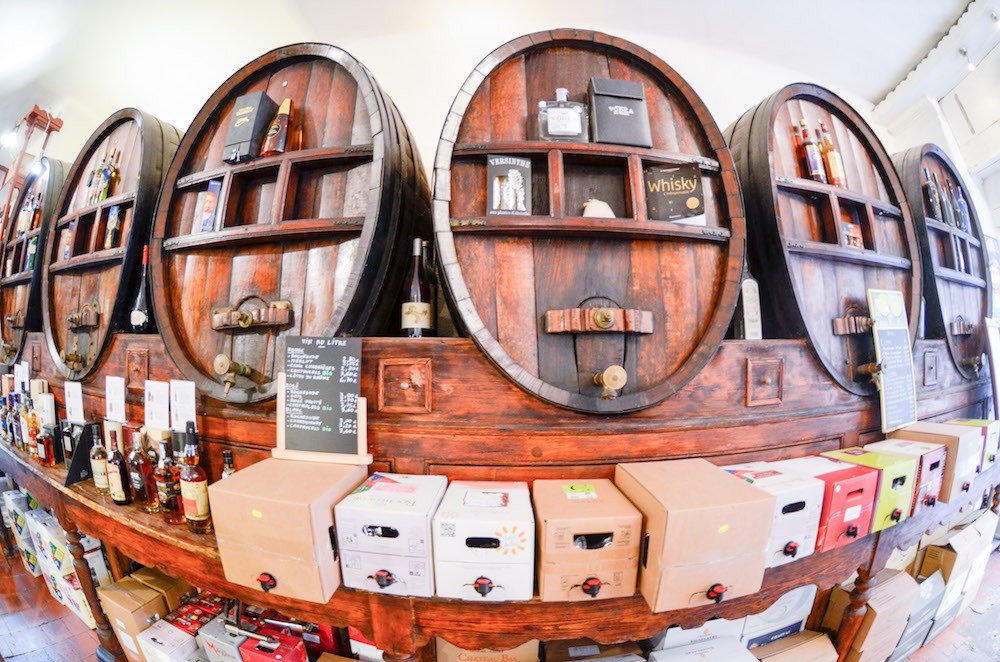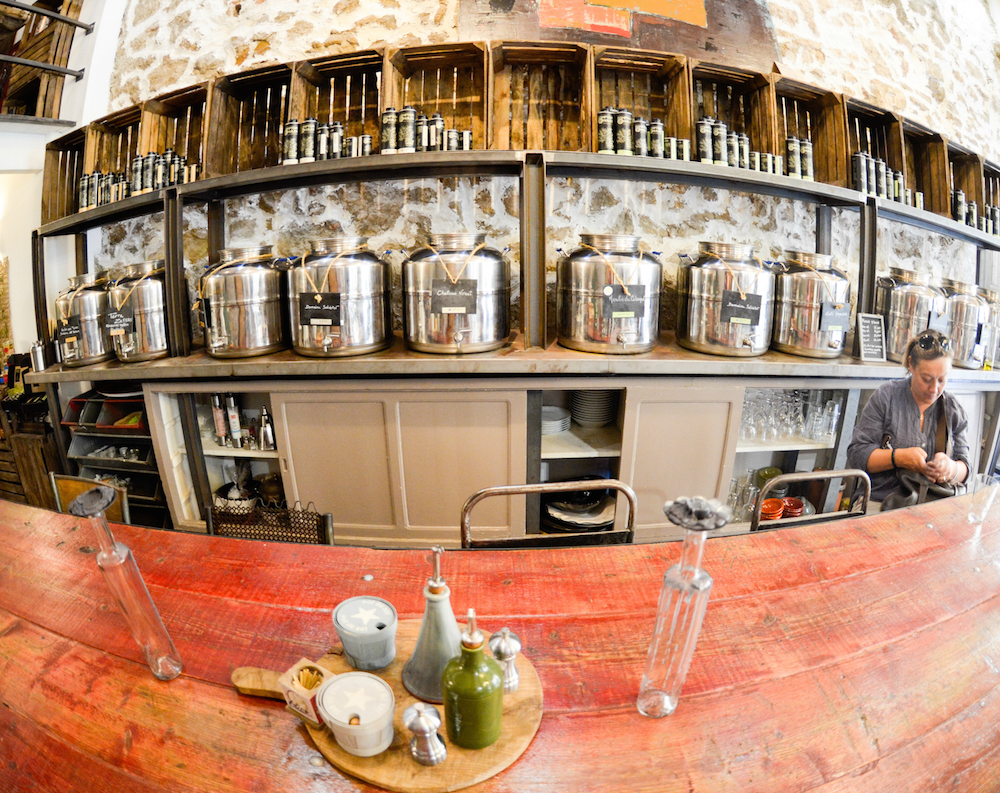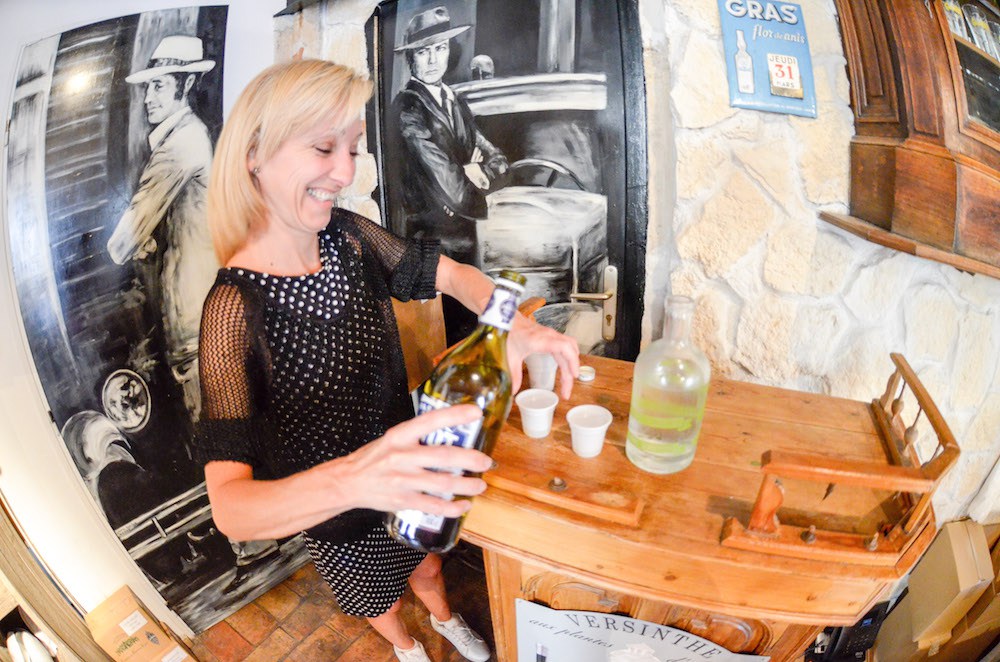“French food is not all the same. In Marseille, we have our own gastronomic specialties.”
If there’s anything Andy and I learn in the final stretch of our two-week road trip from Nice to Marseille, it’s that while many dishes overlap, there are also regional specialties through France.
We continue to digest this — literally — on a gastronomic tour of local specialties with Marie-Pierre Vouriot, a local guide and food enthusiast. She meets us near our accommodation, New Hotel Vieux Port, which is adjacent to Marseille’s historic Old Port. The port dates back to 600 BC when it was used by the Greeks, and over time has led to an influx of immigrants from all over — North Africa, Armenia, Italy, Greece, Turkey, Russia and more — as well as trade, both of which heavily influenced Marseille’s food and drink culture. For instance, the Spanish should be given some credit for Marseille’s famous bouillabaisse, as they brought with them one of this Provençal fish stew’s essential ingredients, saffron.
Exploring Le Panier
Our food walk takes place in Le Panier, Marseille’s oldest neighborhood. It’s rich history includes being the agora (marketplace) in ancient Greece and sadly being blown up during WWII. Marie shows us photos of this, also pointing out one building that was spared and still stands today. Many visit Le Panier to see the gorgeous Centre de la Vieille Charité, a complex full of cultural institutions like the Museum of African Arts, the Museum of Mediterranean Architecture and the Le Miroir Cinema. Andy and I, however, have come to explore the food.
Interestingly, while Le Panier is full of history and cultural institutions it’s also oozing modern hip, with artisanal shops, street art, restaurants with loads of outdoor seating, and vendors selling accessories and soaps from stalls. Definitely don’t miss this neighborhood, whether you take a tour or not.
Craft Beer & Soap In Marseille
On our excursion we begin at a little boutique called Ou est Marius? selling second-hand Provençal housewares and locally made products like wine, olives, boules (the special balls for pétanque), handmade calissons (sweets from Aix-en-Provence), rum and Marseille soap (Savon de Marseille).
A quick note on the soap, which has been produced since at least the ninth century and is used for skin and household cleaning. True Savon de Marseille is crafted with 72% olive oil plus coconut and palm oils, a completely biodegradable cruelty-free creation. Because there is no protective designation for Savon de Marseille, you’ll need to rely on little tricks for knowing if you have the real thing, like looking for a collective mark (like the one shown below) or a stamp with its weight in grams.
Andy and I buy these delicate soaps in bulk for gifts, before sampling a surprising glass of local rice beer.
When I first offered a taste of the beer I can’t help but think of Japan and their Japanese rice wine (sake) over Marseille; however, the Camargue region, just an hour outside of Marseille, has had a flourishing rice industry since WWII.
Drinking the beer also gets us into the discussion about the growing trend of craft beer in Provence. While beer has been brewed in France for a long time, especially near the Belgian border, it’s only within the last decade or so that numerous craft brewers have opened up shop around the country, answering to locals’ calls for boozy choices beyond wine. Today there are hundreds of breweries in France.
A Cookie With A Captivating History
Next we soak up the alcohol with a local Navette biscuit from Les navettes des Accoules. Navette means “shuttle,” and the cookie is shaped like a boat paying homage to a time over 2,000 years ago when St Lazarus, Saint Mary Magdalene and Saint Martha arrived to Saintes-Maries-de-la-Mer in Provence by boat. Marie explains the cookie contains flour, sugar, eggs, butter — no yeast — and a “special ingredient” that Andy and I are to guess.
I bite, chewing the slightly sweet cookie with thought. It’s not apparent at first, but there’s definitely a floral fruity taste at the end.
“Tangerine? Mandarin? Orange?” I guess.
Marie laughs. “You’re very close! But it’s not the actual fruit that’s in the Navette.”
“Orange seeds? Peels? Zest?”
In the end, we learn it’s orange blossom, which makes a lot more sense than orange seeds. Marie also points out a treat called cucciole, a cookie made with wine — that locals also dip in wine — that comes from Corsica. That bakery owner is actually from Corsica, a prolific demographic in Marseille, which has an influence on the food.
It’s at this stop that Marie also blows Andy and I’s minds by telling us that croissants are not from France.
NOT FROM FRANCE?!?
“Marie Antoinette brought them with her from Austria. It’s like ‘French fries,” which are actually from Belgium.”
Wow. Americans are confused.
A Street Art Aside
The streets of Le Panier continue to wind, and we come to a familiar looking style of street art. Os Gemoses, who have a street art mural in Coney Island, apparently have a shop called UndArtGround in Marseille. Inside we find everything art, from creative coloring books to paint supplies to graphic tees.
Wine & Cheese Please
This creative reprieve gives us time to digest before our most hearty stop, La Descente des Accoules. It’s the oldest wine shop that has always operated as a wine shop in Marseille, selling vino since 1899, though they now offer local beer and spirits to give people more choice. We sample a dry Provençal rose, a popular style of wine in Marseille where 75% of what’s consumed is rose. It’s paired with locally made bread and two types of cheese, a super light and creamy Chèvre Fermier from Verdon and, possibly the best cheese we’ve ever had, a firmer Medailon Fermier.
The platter is more than enough for four, and upon first glance I don’t think we’ll finish it. But when a pairing is this delicious you don’t let it go to waste. In New York I’d stop myself after just a a few bites in an effort to keep my waistline, but either buzzed on wine or great flavors I’m powerless to stop.
Olive Oil Heaven
Speaking of wine, at nearby Comptoir O Huiles we learn olive oil is a lot like the drink, with varying terroir leading to a plethora of aromas and flavors. The owner of the shop is a beautiful woman with a beaming smile and her eyeshadow artfully done in the French flag. She’s a professional taster in international olive oil competitions, and tells us that there are three types of flavor profiles to look for with olive oil: fruity, bitter and spicy.
For the latter she points to her throat. “You’ll feel it here. Some people think medium spicy olive oils are spicy, but I have very spicy olive oils here.”
We sample four very diverse oils that showcase aromas — olive oil judging is 40% nose and 60% mouth — and flavors ranging from banana to black pepper. My personal favorite is an oil which tastes just like fresh cut grass. It reminds me of being a kid again, running around the lawn with my soccer ball. It’s a memory that’s as pleasing as the oil itself.
Back To Booze
We end with Marseille’s signature aperitif at Janot, pastis. Anise-based drinks are a tradition in most Mediterranean countries, the plant’s native home. In 1915 the popular anise-flavored absinthe was banned, the scapegoat of the temperance movement and the French winemakers whose business had been hurt by phylloxera killing their vines. At this time other anise-based drinks started popping up, like pastis, made popular in 1932 by Paul Ricard.
While exact recipes differ between pastis distillers, you’ll always have anise, a blend of herbs, sugar and actual licorice root. It has a strong flavor, so the French like to mix it with water, which also leads to a “louche” effect (meaning the drink turns cloudy). It’s made at around 45 proof, and makes for a great digestif. Healthy and historic!
Boules & Balls
After a short pétanque lesson at La Boule Bleue, Andy and I head back to the Old Port for dinner at Chez Madie les Galinettes. The weather is perfect for a seaside meal, the sounds of clicking rose glasses and waves lapping onto docked boats the soundtrack of the meal. We’re close enough to the Port’s giant Ferris wheel to enjoy it lit up at night, but far enough away to not hear the delighted shrieks (until afterward, when we go for a ride ourselves!).
While our day focused on exploring Marseille’s simple yet sumptuous specialties, our dinner begins with a unique specialty of the house we never thought we’d be tasting in France (or anywhere), lamb testicles. We order it to be adventurous, but are actually surprised at how much we enjoy the dish, a tender flat cutlet in a tomato-based sauce that thankfully does not resemble balls. Hey, travel is about trying new things, right?
And it’s about truly discovering the place you’re in. Food is one very enjoyable way to do this. While our paired rose wine allows us to taste Provence through the palate, a dish of linguine with local clams reminds us of our waterfront location. With the beef stew, we taste a classic centerpiece of French cuisine.
And the testicles? Well, the dish doesn’t have much to do with Marseille, but allows us to satiate a little thirst for adventure. We sip, bite, talk and laugh, enjoying the ambiance and food’s power to bring people together, as well as to tell the story of a place. Cheers to that.
Have you explored food in Marseille? Please share your experiences in the comments below!
Logistics:
Stay: New Hotel Vieux Port. Rates start at 140 Euros (~$156 USD) per night, with a great location adjacent to the Old Port (Vieux Port). My room had an aerial view of the Old Port, allowing me to take in boats, water views and entertaining buskers while sipping Provencal rosé from the balcony.
Driving In Marseille: While I recommend having a car in France, know that French drivers make New York drivers seem sane and polite. Driving in Marseille was somewhat stressful with skinny streets, crazy cars, minimal parking aside for garages, and pedestrians and motorbikes that seemed to have a death wish. Definitely leave the car parked as much as possible, using it only for day trips and traveling your trip route.
Getting Around Marseille: Marseille has excellent public transportation. Use the RTM website to help you navigate public buses. All buses cost 1.50€ if you buy it in the city and 1.90€ if you buy it on board. The validity lasts 60 minutes. There are also ferries, trams and metros. Click here for more information.
Great Reads: Au Contraire: Figuring Out the French and How the French Think: An Affectionate Portrait of an Intellectual People.
Safety Essentials: While I found Marseille to be relatively safe, it is a big city and crime exists. I always travel with Clever Travel Companion Pickpocket-Proof Garments and a Vigilant Personal Alarm.
Language: French, though we found many people spoke some English. Just make sure to understand pleasantries when interacting with locals!
Currency: Euro. As of September 2016 the exchange rate was about 1 Euro = $1.13 USD.
France Road Trip Route:
- Nice (with day trips to Eze for a medieval village, Monaco for a VIP afternoon and Saint-Jean-Cap-Ferrat for the Villa & Jardins Ephrussi de Rothschild)
- Cannes (with day trips to St. Tropez/Ramatuelle for beaches, Gassin for wine tasting and La Croix Valmer for beaches and hiking)
- Moissac Bellevue (we stayed at a woodland set horse farm then were about 20-minutes from Verdon Gorge)
- Hyeres (the cobbled commune itself is fun to explore, and is near beautiful beaches and is accessible to the untouched Port Cros Island; worth the trip for this cool castle stay alone!)
- Aix-en-Provence (my personal favorite spot of the trip due to the small quiet city full of amenities and accessibility to beautiful Provence farmland; a cheesey rooftop lunch at La Fromagerie Du Passage and a day trip cycling outside the city with Arthur of Secrets d’ici are musts!)
- Marseille (don’t miss hiking in the urban Calanques National Park, which doesn’t feel urban at all and is accessible to beautiful port towns and beaches)

Jessica Festa is the editor of the travel sites Jessie on a Journey (http://jessieonajourney.com) and Epicure & Culture (http://epicureandculture.com). Along with blogging at We Blog The World, her byline has appeared in publications like Huffington Post, Gadling, Fodor’s, Travel + Escape, Matador, Viator, The Culture-Ist and many others. After getting her BA/MA in Communication from the State University of New York at Albany, she realized she wasn’t really to stop backpacking and made travel her full time job. Some of her most memorable experiences include studying abroad in Sydney, teaching English in Thailand, doing orphanage work in Ghana, hiking her way through South America and traveling solo through Europe. She has a passion for backpacking, adventure, hiking, wine and getting off the beaten path.

